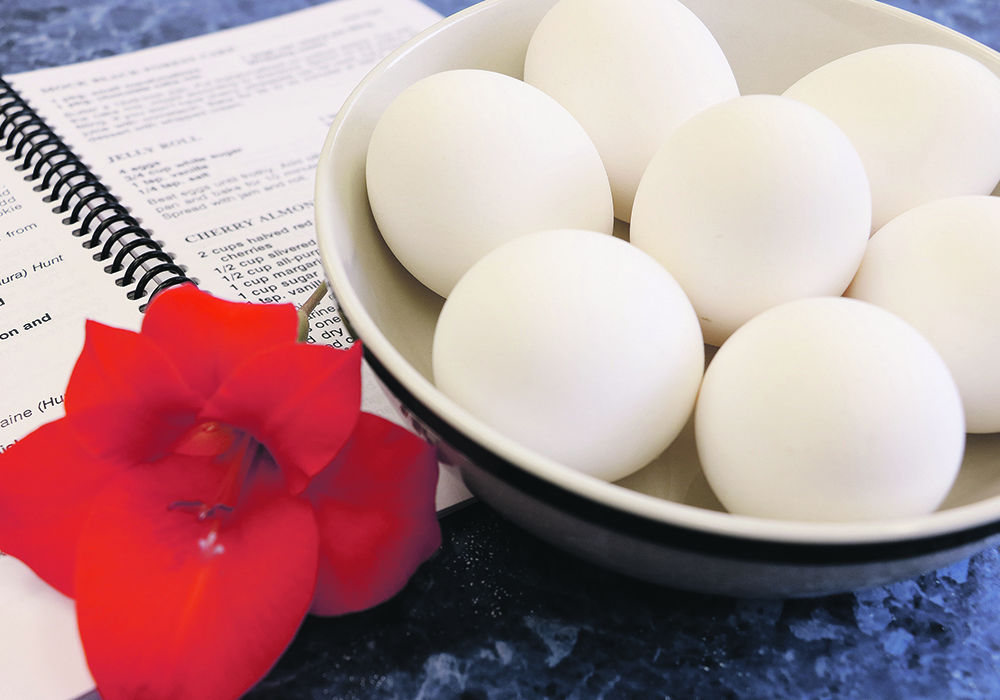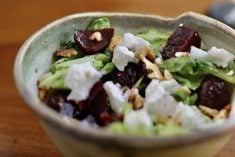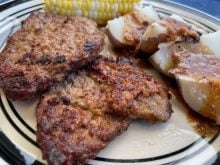Have you ever gone to make a recipe, only to discover that you don’t have some of the ingredients? It’s also possible that some of the people you’re cooking for may choose not to eat certain foods due to food allergies or a diet choice and are looking for an alternative food.
One of the first considerations when substituting a food in a recipe is to determine the role of the missing ingredient. Does it add flavour, is it used as leavening to help the mixture rise and does it add moisture or texture to the recipe?
Eggs
Read Also

Communication key to bridging generation gap
Each generation is shaped by the predominant forces at play during their formative years. Acknowledging these influences can improve communication among the generations.
Eggs are a common ingredient in baking, where they may act as a binding agent, provide leavening, add moisture and affect texture. In sauces and custards, they help thicken and emulsify.
To replace one large egg:
• Use 1 tbsp. (15 ml) ground flax or chia seeds mixed with three tbsp. (45 mL) water and let stand about 10 minutes to form a gel. This works as a binding agent in pancakes, waffles or cookies. Add an additional 1/2 tsp. (2 ml) baking powder to the flour mixture for added leavening in cakes and muffins.
• Use 1/4 cup (60 mL) mashed bananas, apple sauce, pureed pumpkin or pureed avocado to replace the moisture an egg would have provided in cakes, muffins and fruit flavoured desserts. If leavening is also needed, add an additional 1/2 tsp. (2 mL) baking powder to the flour mixture.
• Use 1/2 tbsp. (7 mL) cornstarch or one tbsp. (15 mL) flour to replace one egg. If a recipe calls for several eggs to thicken a mixture such as custards, pies or cooked salad dressings, use cornstarch or flour to replace one or two eggs but not all the eggs.
• Use one tbsp. (15 mL) powdered gelatin dissolved in two tbsp. (30 mL) hot, not boiling, water and stirred until completely dissolved to replace one egg white when making macaroons, meringues and icing. Double or triple for more egg whites. Icings made with gelatin do not crack when dry and have a nice gloss.
• Aquafaba is the liquid found in canned beans or chickpeas and can be used in place of egg whites. Whip the cloudy liquid until it turns to a thick white substance resembling whipped egg whites. For one whole egg, use three tbsp. (45 mL) aquafaba, while for one egg white use two tbsp. (30 mL) aquafaba. Use in meringues, mousse and other light baked goods. Aquafaba is a good substitute if baking is already dense, such as banana muffins or pumpkin loaf.
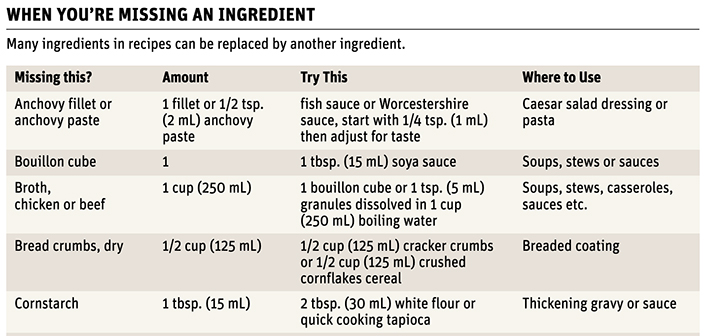
Milk
Milk provides moisture and tenderness in baked goods. It also encourages the browning reactions characteristic of pastry crusts, cookies and biscuits. Milk contributes to the keeping quality of bread and gives it a soft crust.
To replace one cup (250 mL) milk:
• Use 1/3 cup (75 mL) powdered milk plus one cup (250 mL) water. Powdered milk has a significantly longer shelf life than regular milk if stored in a moisture proof container in a cool, dry place.
• Use 1/2 cup (125 mL) evaporated milk and 1/2 cup water.
• Plant-based milks such as almond, cashew, oat, soy and rice can be used in baked goods and sauces using a one to one substitution. The nut milks may give a nutty flavour, and sweetened milks may be too sweet for savoury dishes.
Buttermilk
Buttermilk, sour milk or yogurt can replace each other in a recipe or use the following to replace one cup (250 mL) for any of them:
• Add one tbsp. (15 mL) white vinegar or lemon juice to one cup (250 mL) milk, stir and let sit for a couple of minutes. Use in pancakes, biscuits, buns and cakes.
Butter
Butter creamed together with sugar incorporates air into the mixture, which helps baked goods rise and creates a tender texture in cakes and cookies. Butter contains water, and when the water evaporates, it creates flaky layers critical to a pie crust or biscuit. Butter also adds richness and flavour, especially to creamy soups and sauces:
• Margarine and plant-based butters are derived from vegetable and nut oils. They are available as solid blocks or as soft spreads. The solid blocks work well in recipes replacing butter using a one to one substitution. The soft spreads do not because they contain too much water and air.
• Canola and other oils can be used to replace butter in most recipes. In baking, for one cup (250 mL) of butter use 3/4 cup (175 mL) of oil. For stovetop cooking, use a one to one substitution. Cakes may be much denser when oil is used.
• Applesauce or pureed cooked white beans can be used to reduce the fat in baking. Substitute half the butter, margarine or oil in the recipe for any of the above. This substitution works best in dense recipes such as brownies, cakes, muffins or bread. Cookies will be soft rather than crisp and chewy.
• Bacon fat or beef drippings can be used in place of butter in biscuits or for stovetop cooking. Use a one to one substitution. Strain these fats before using.
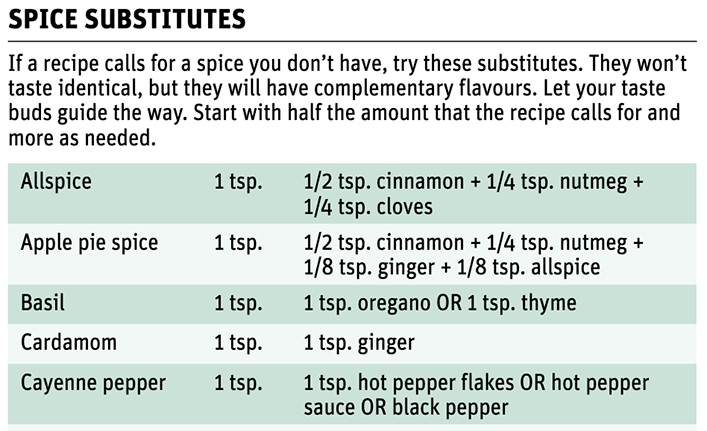
Sugar
Sugar adds tenderness to dough and a golden brownness to baked goods. It provides stability to mixtures such as beaten egg whites for meringue and in sufficient quantity it can contribute to preservation in some foods. Granulated white sugar is the most common form for cooking.
• Brown sugar can be used to replace white sugar in most recipes. It may give a slightly golden colour. When brown sugar is measured, it must be pressed down tight into the measuring cup. Use a one to one substitution.
• White sugar can replace brown sugar with a one to one substitution plus one tbsp. (15 mL) molasses.
• Icing sugar should be sifted before using. To replace one cup (250 mL) of white sugar, use 1 3/4 cup (425 mL) icing sugar.
• Corn syrup or honey can be used to replace either white sugar or brown sugar using a one to one substitution, but the liquid in the recipe must be reduced by 1/4 cup (60 mL).
Molasses
Molasses is the syrupy mixture from which sugar is extracted. There are three varieties: light molasses from the first boiling, dark molasses from the second boiling and blackstrap from the third boiling. Each is a little less sweet and stronger in flavour:
• Dark corn syrup, honey or maple syrup can be used to replace molasses using a one to one substitution.
• Use 3/4 cup (175 mL) firmly packed brown sugar to replace one cup (250 mL) of molasses.
Baking powder and baking soda
Baking soda cannot be substituted for an equivalent amount of baking powder because an acid also needs to be added to the recipe. A smaller amount of baking soda is used.
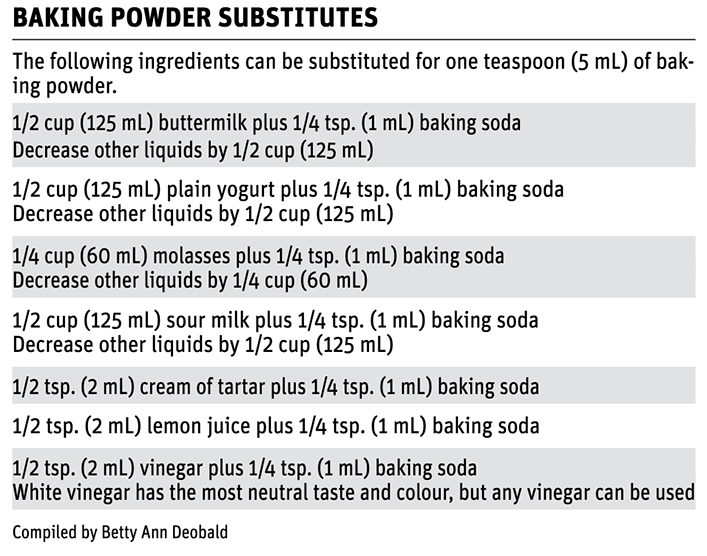
To substitute one teaspoon of baking soda, use three teaspoons of baking powder.
Baking powder and baking soda can be replaced in a recipe with club soda. It is a carbonated beverage that contains sodium bicarbonate or baking soda. Club soda gives volume to baked goods and is commonly used to create fluffy, moist pancakes. Omit the milk or water in the recipe and replace it with an equal amount of club soda.
Not all substitutions are created equal. The original ingredient is there for a reason and substituting it with another may result in a different taste, texture or colour. However, some recipes will be completely unaffected. Assess any substitution you make in a recipe, and make a note on the recipe for future reference.
Betty Ann Deobald is a home economist from Rosetown, Sask., and a member of Team Resources. Contact: team@producer.com.


